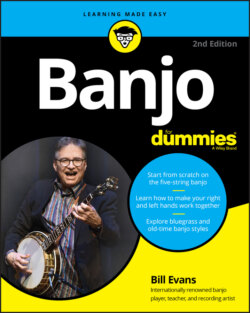Читать книгу Banjo For Dummies - Bill Evans - Страница 43
Talking Banjo Talk
ОглавлениеMany folks prepare for a trip to a foreign country by practicing a few phrases in the language that's spoken there. Playing the banjo is very much the same kind of adventure — it's great to know banjo speak before you start to make banjo music. Plus, you may find Banjo For Dummies a little clearer if you know some of the basic terms I use throughout this book.
Although that banjo-playing kid in the Deliverance movie didn't talk very much, it's still helpful to familiarize yourself with the following basic banjo terms:
Left hand: When I give you any instructions regarding the left hand, I'm referring to the hand you use to push the strings against the fingerboard to make chords (you do this with the tips of your fingers, of course, not the entire hand). You also use the left-hand fingers to create new notes on the banjo by using slides, hammer-ons, pull-offs, and chokes (slide on over to Chapter 6 to discover more about these special techniques). If you're a left-handed banjo player playing a banjo especially made for left-handed players, you make these same moves with your right hand.
Right hand: The right hand is the hand that strikes the banjo strings. In Banjo For Dummies, you first use the right-hand thumb to strum across all the banjo strings, but soon enough you utilize techniques where the right-hand thumb and the index and middle fingers each play a different role in producing authentic right-hand banjo styles (you can find these techniques in Chapter 5). If you're playing a left-handed banjo, you use your left hand to make these moves.
Frets: The raised metal strips that run along the top surface of your banjo fingerboard underneath and perpendicular to your strings are the frets. Most banjos have 22 frets with each fret assigned a number. The 1st fret is the fret that's closest to the nut and the 22nd fret is located the closest to the banjo head.
Fretting: The act of pushing one or more left-hand fingers against the fingerboard just behind a fret to shorten the length of a string is called fretting. Fretting changes the sound (or pitch) of a note. The shorter the length of a string, the higher that string's pitch — and the higher up the neck you're fretting. (For more on fretting, you can check out the section “Fretting with the Left Hand” later in this chapter.)
Open: You call an unfretted string an open string. Later in this chapter, you're introduced to tablature, the written form of banjo music. In tablature, an open string is indicated with the number 0.LEFT-HANDED BUT NOT LEFT OUT!If you're left-handed, playing the banjo creates a unique challenge. Unlike a guitar or mandolin, you can't just flip the banjo around and switch hands to play because the shorter 5th string tuning peg will no longer be positioned as it should be on the top of the banjo neck. If you already own a right-handed banjo, try playing it in the right-handed way for a couple of weeks and see how it goes. On the other hand, if you don't yet own a banjo or if you're experiencing a great deal of frustration trying to play in that strange right-handed way, pay a visit to your nearest full-service acoustic instrument store and try out a left-handed instrument. I guarantee that after you try both kinds of banjos, you will know very quickly which kind will be best for you.Full disclosure: I'm left-handed but I learned to play right-handed. However, I've taught several left-handed students who wouldn't play any other way than with a left-handed instrument.
Strings: Yeah, I know you know what strings are. But banjo players are so methodical that they assign numbers to each string so they can talk about them more easily. Remembering the order of strings as expressed through these numbers is crucial to understanding banjo tablature and interpreting a chord diagram, which is a representation of how a chord is fretted.
The 5th string is the short string on your banjo. If you're holding the instrument in a playing position (see the following section, “Positioning Body and Banjo”), the 5th string is the string that is the closest as you look down at the strings. From the 5th string, the strings are then numbered 4, 3, 2, 1 across the banjo. The 1st string is the farthest away from you as you look down on the instrument.
Sharp and flat: You use these terms in reference to getting the banjo in tune. If a note you're playing on your banjo is sharp, its pitch is higher than the note you're trying to tune to; if its pitch is lower, your banjo note is flat.
